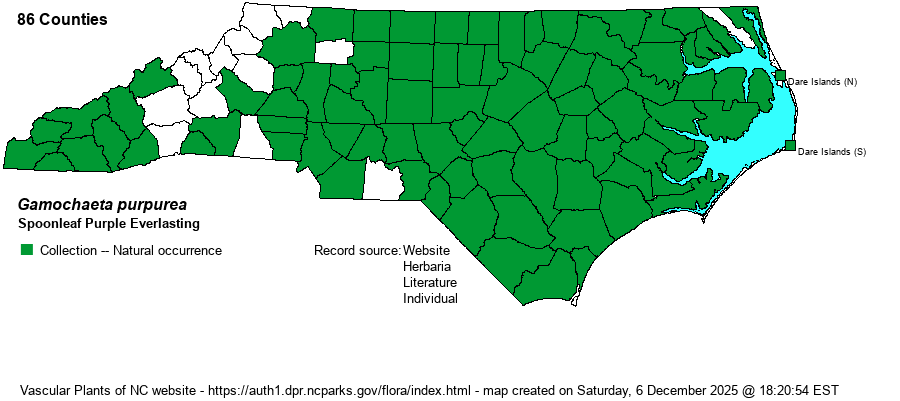| Author | (L.) Cabrera | |
| Distribution | Coastal Plain, Sandhills, Piedmont, and southern Mountains; scarce in the upper Piedmont and northern Mountains.
Southern ME to MI, south to FL and TX; much of Latin America. | |
| Abundance | Generally common across the Coastal Plain and most of the Piedmont. Fairly common to common in the southern Mountains. Scarce in the foothills and northern Mountains. This is probably the most geographically widespread of NC's numerous species in the genus, but not the most numerous individuals. | |
| Habitat | Moist to dry (even irregularly inundated) soils of pine savannas and flatwoods, depression ponds, interdune swales, blackwater streamhead ecotones, Longleaf Pine pea swales, openings in forests and woodlands, roadsides, clearings, disturbed soil. | |
| Phenology | Flowering and fruiting late March-September. | |
| Identification | The original Spoonleaf Purple Everlasting has been split into several species, some native and some alien; see the key in Weakley (2024). As now understood, this species occurs in a number of natural habitats, as well as ruderal ones, whereas the segregates -- most native to NC and the U.S. -- occur almost entirely in ruderal and disturbed habitats. Spoonleaf Purple Everlasting belongs to the group that has bicolored leaves: the upper surface is green while the underside is whitened with dense hairs. Note that some plants will have basal and lower leaves essentially green above and stem leaves practically whitened on both surfaces; these will not key cleanly. The species differs from G. argyrinea in its narrower leaves that are spatulate (vs. oblanceolate or obovate) and taller involucres (4-4.5 mm long vs. 3-3.5 mm long). | |
| Taxonomic Comments | Formerly treated as Gnaphalium purpureum. RAB (1968) had this taxon as part of the var. purpureum.
| |
| Other Common Name(s) | Purple Cudweed | |
| State Rank | S5 | |
| Global Rank | G5 | |
| State Status | | |
| US Status | | |
| USACE-agcp | UPL link |
| USACE-emp | UPL link |

